The use of portfolios on efl young learners’ sentence writing: A case at an english language centre in the Mekong delta
In foreign language learning, the ability to write effectively is becoming more and more important
(Weigle, 2002). In addition, as Nezakatgoo (2011) mentioned, writing is the most difficult skill for EFL
learners to master. It is more than production of these graphic symbols. The graphic symbols must be
arranged in such away according to certain conversion, to form words to form phase. The shift in writing
theory from writing products to that of writing processes has led to the popularity of portfolios among
educators as an alternative approach both in English as a Foreign Language (EFL) and English as a Second
Language (ESL) context as an instructional tool for the exam preparation (Nezakatgoo, 2011). There are
many different ideas of the definition of portfolios, but the common consensus is that portflios are the
purposeful collections of works showing the development of skills, knowledge or experiences over a period.
Basically, the aims of all kinds of language portfolios are to keep records about learners’ language learning
process, to demonstrate how their skills developed in time and to promote language learning (Gonzales,
2009). In this sense, Council of Europe’s Modern Languages Division devised European Language
Portfolio (ELP) to motivate learners by acknowledging their efforts, diversifying their language skills at
levels and providing a record of the linguistic and cultural skills they have acquired (Little, 2002 & Mirici,
2008).
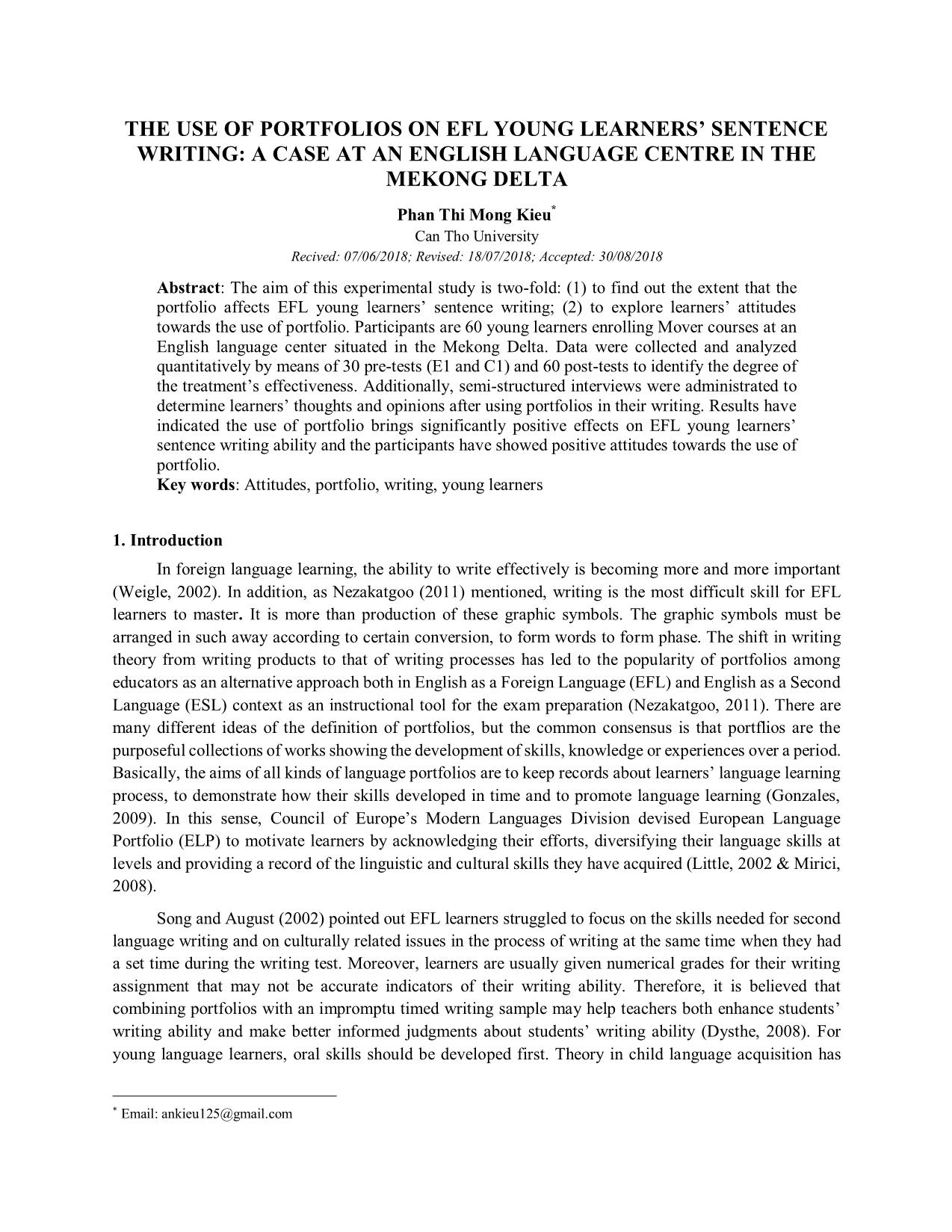
Trang 1
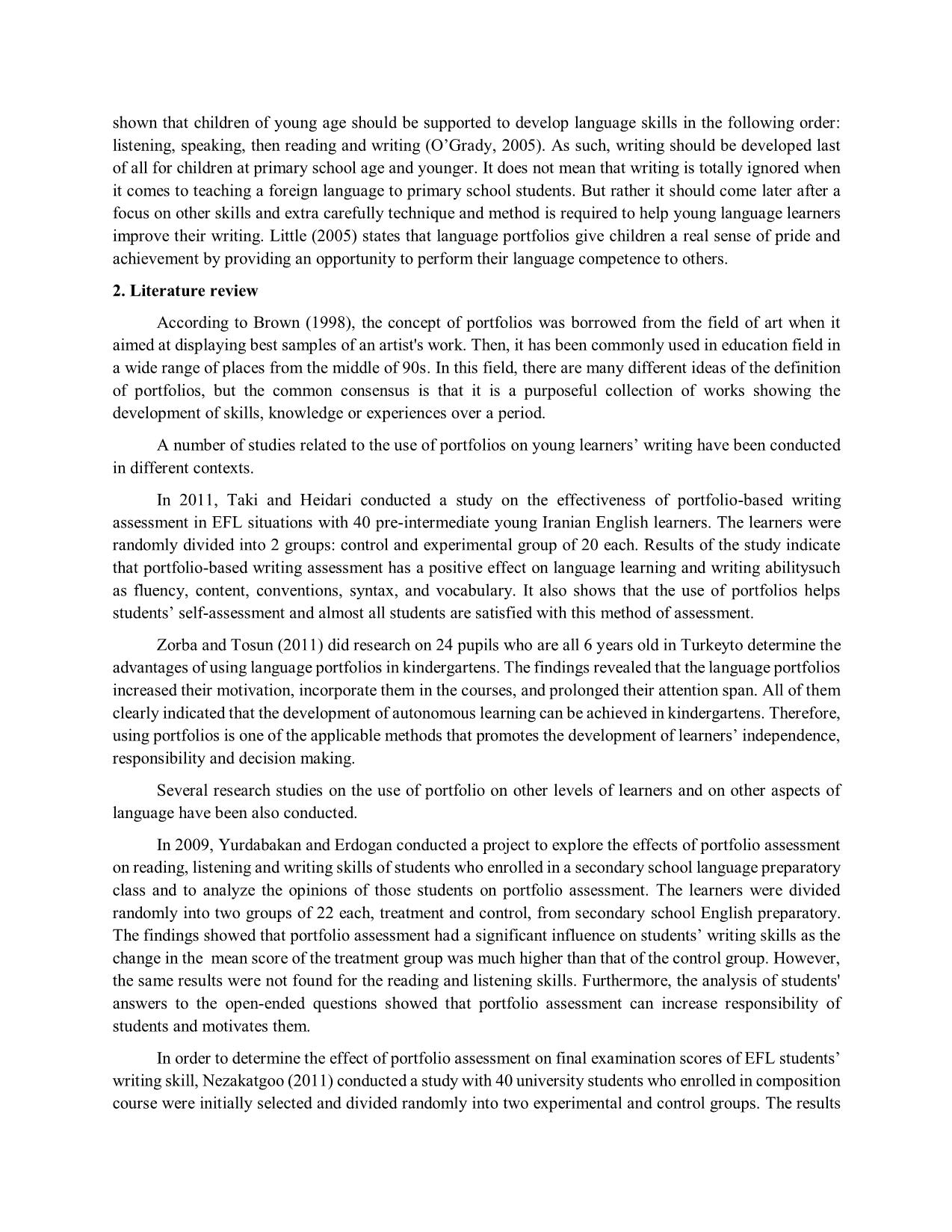
Trang 2
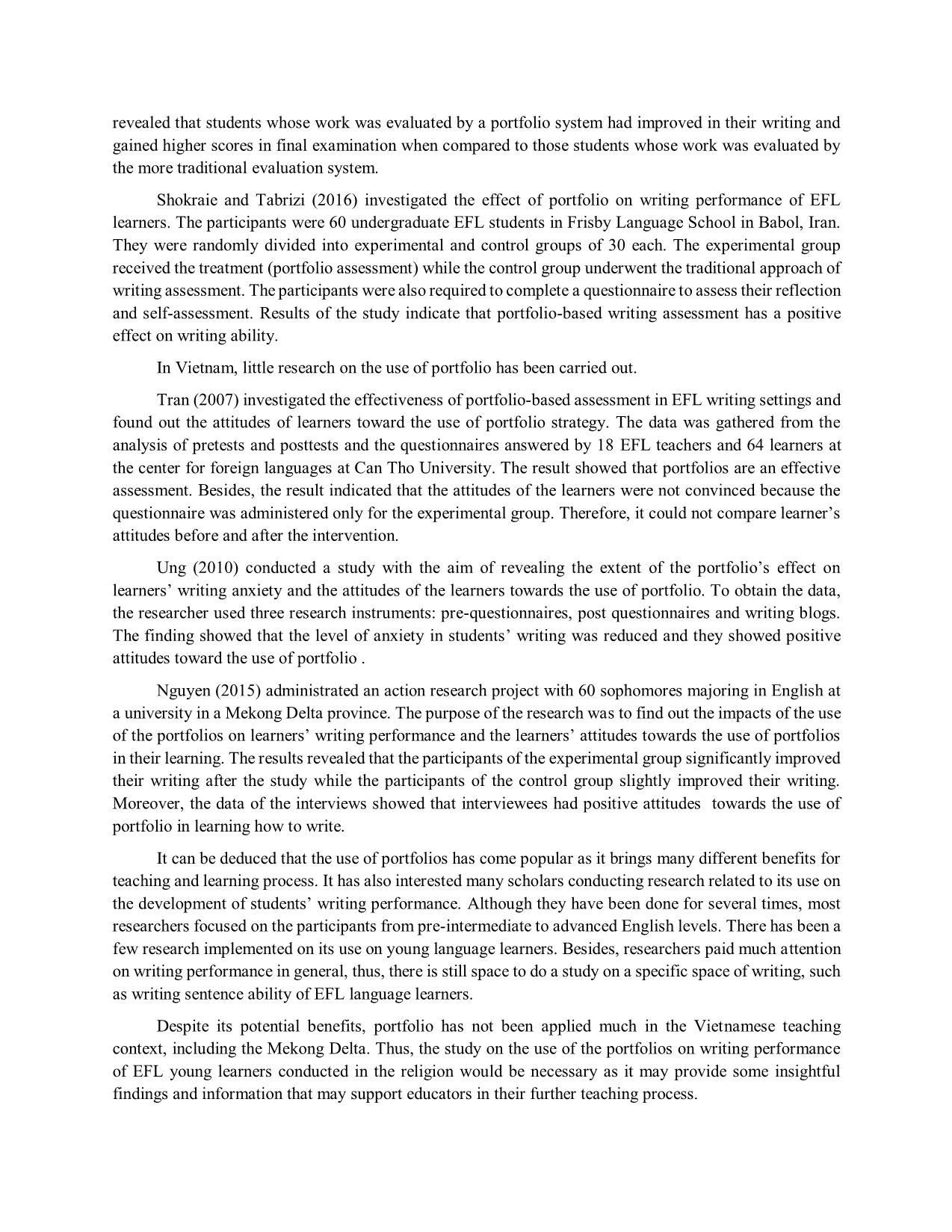
Trang 3
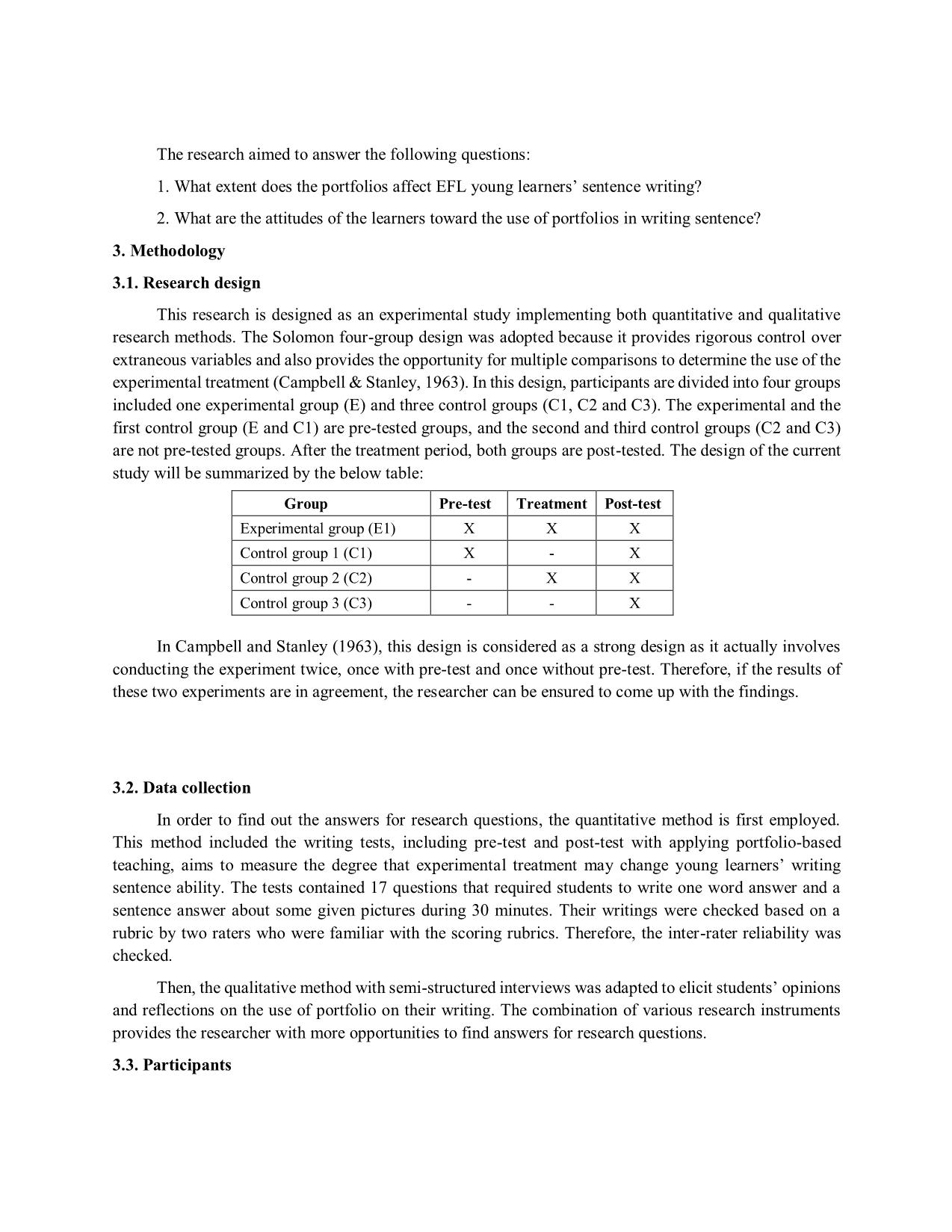
Trang 4
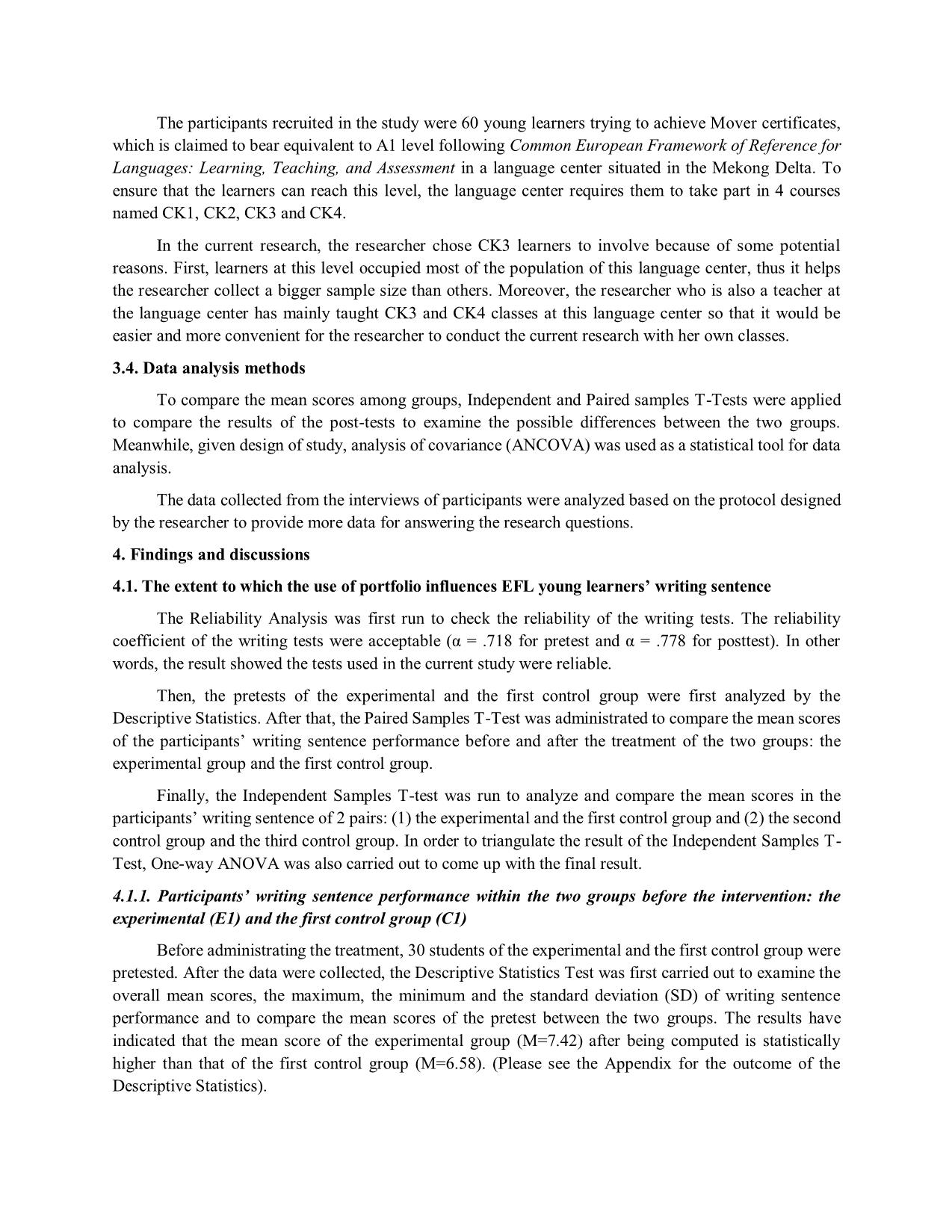
Trang 5
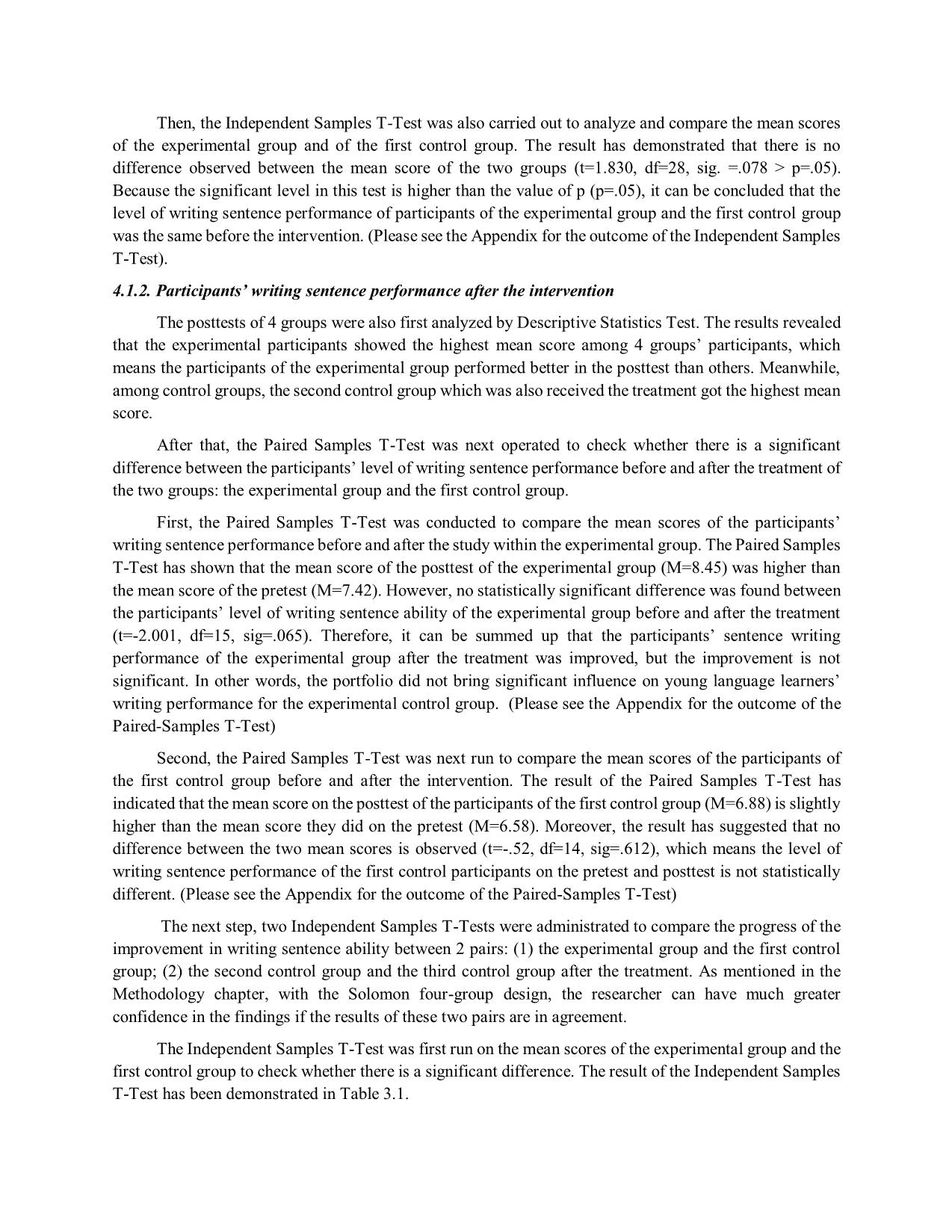
Trang 6
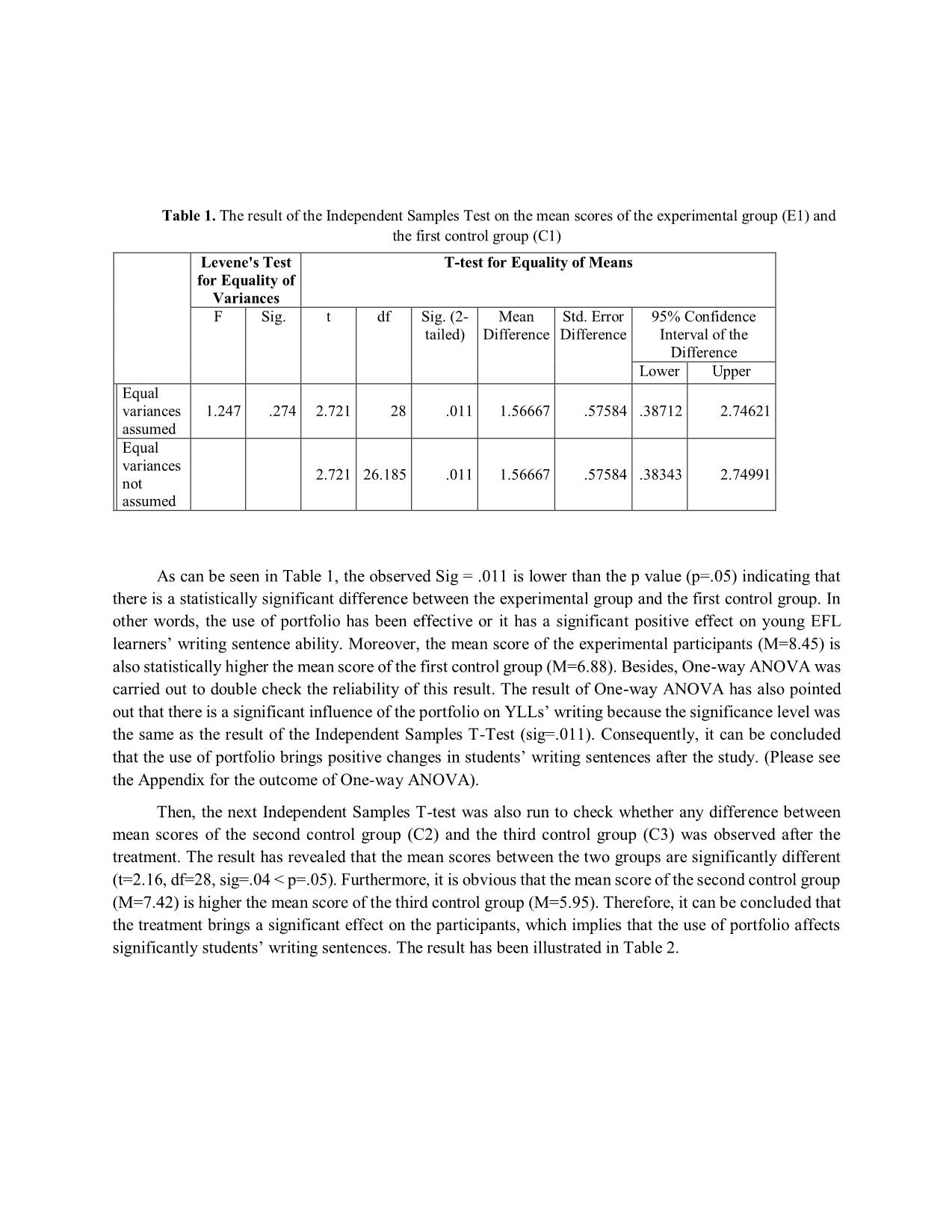
Trang 7
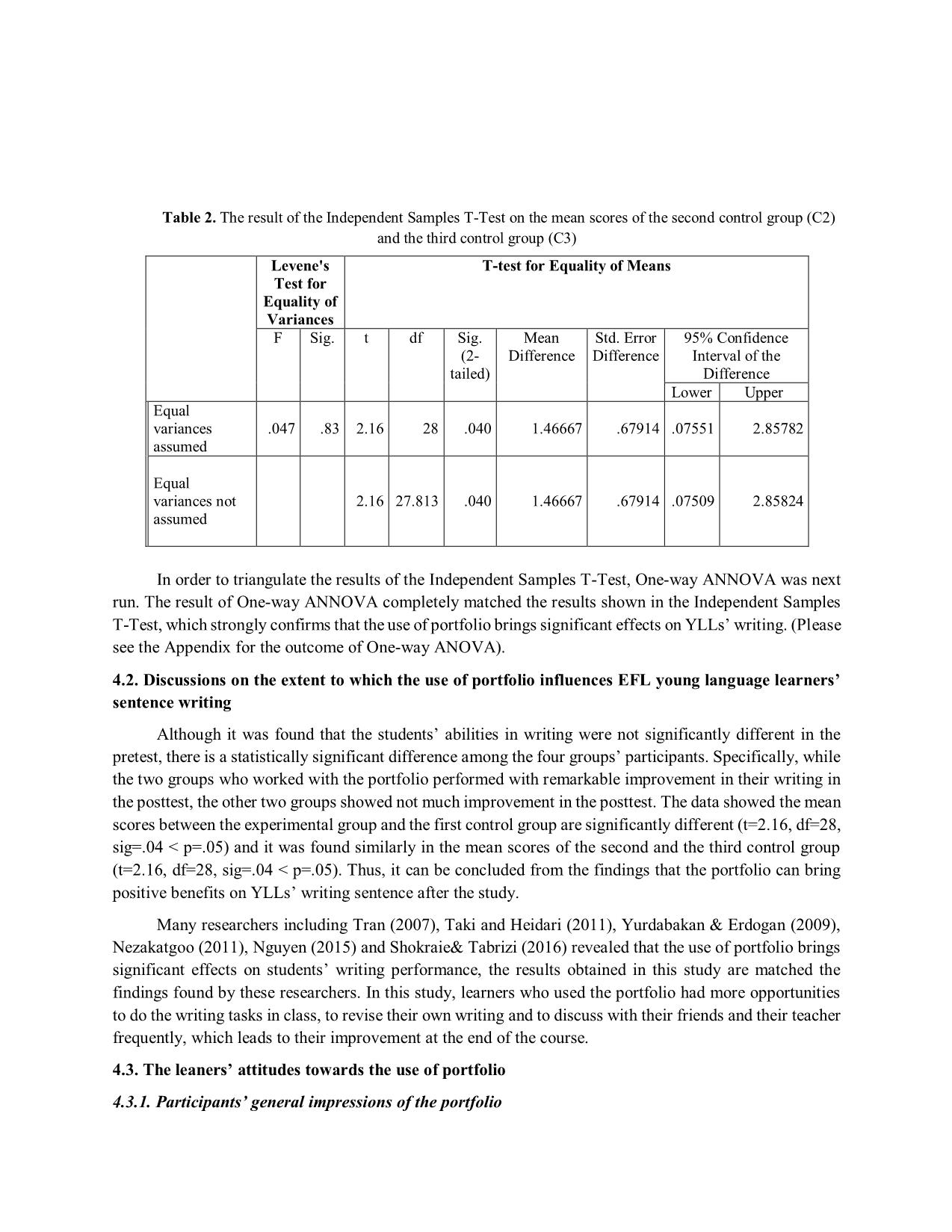
Trang 8
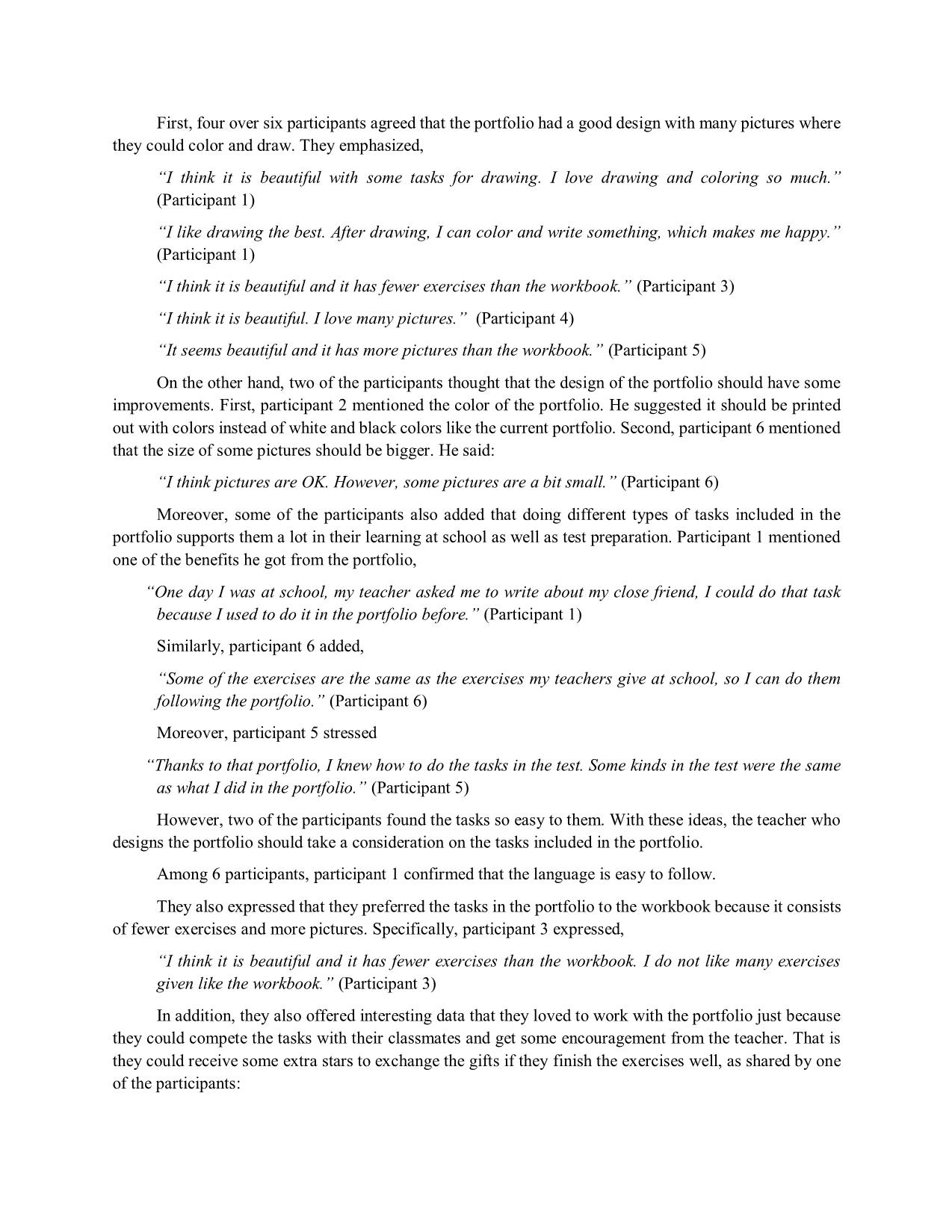
Trang 9
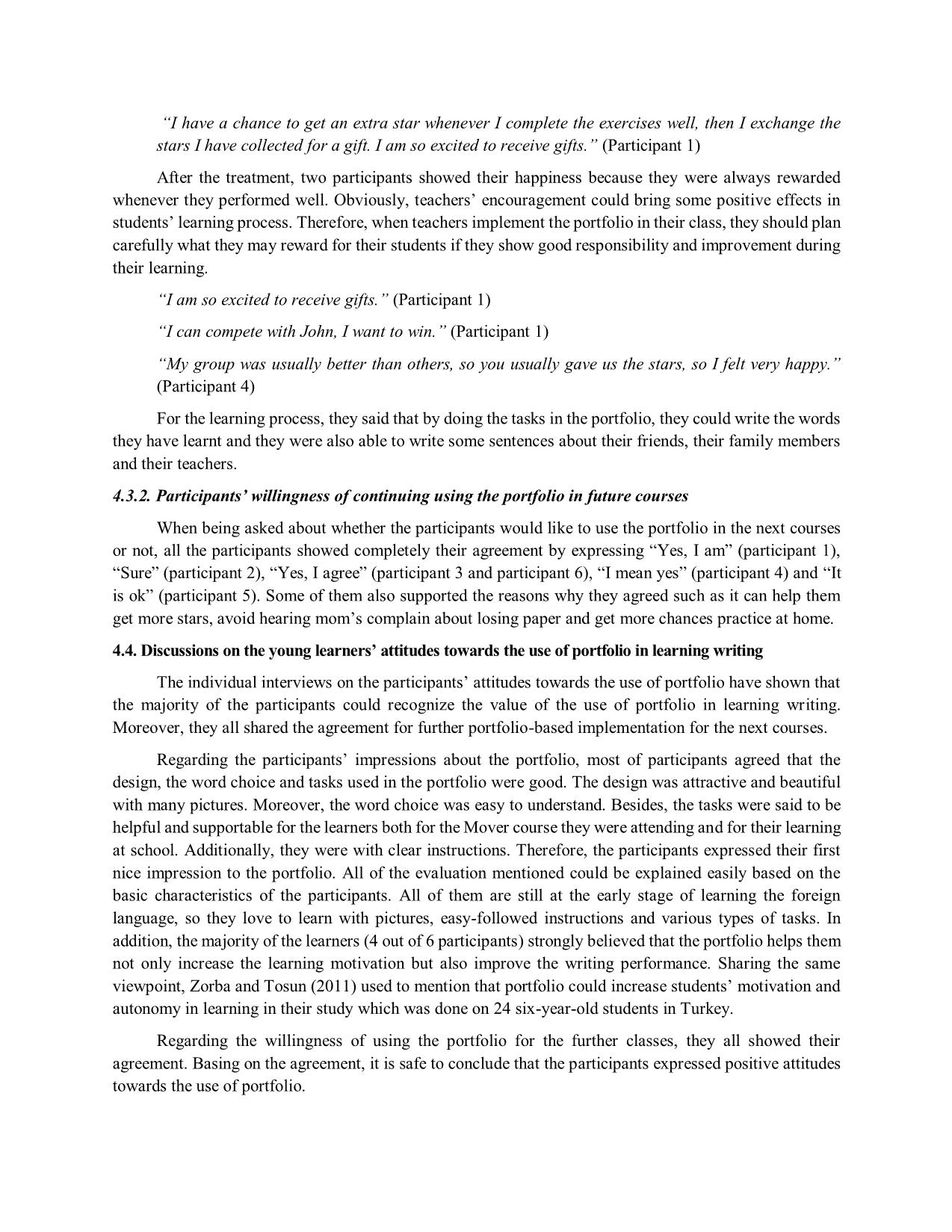
Trang 10
Tải về để xem bản đầy đủ
Tóm tắt nội dung tài liệu: The use of portfolios on efl young learners’ sentence writing: A case at an english language centre in the Mekong delta
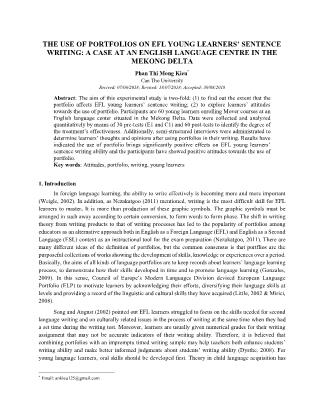
THE USE OF PORTFOLIOS ON EFL YOUNG LEARNERS’ SENTENCE WRITING: A CASE AT AN ENGLISH LANGUAGE CENTRE IN THE MEKONG DELTA Phan Thi Mong Kieu * Can Tho University Recived: 07/06/2018; Revised: 18/07/2018; Accepted: 30/08/2018 Abstract: The aim of this experimental study is two-fold: (1) to find out the extent that the portfolio affects EFL young learners’ sentence writing; (2) to explore learners’ attitudes towards the use of portfolio. Participants are 60 young learners enrolling Mover courses at an English language center situated in the Mekong Delta. Data were collected and analyzed quantitatively by means of 30 pre-tests (E1 and C1) and 60 post-tests to identify the degree of the treatment’s effectiveness. Additionally, semi-structured interviews were administrated to determine learners’ thoughts and opinions after using portfolios in their writing. Results have indicated the use of portfolio brings significantly positive effects on EFL young learners’ sentence writing ability and the participants have showed positive attitudes towards the use of portfolio. Key words: Attitudes, portfolio, writing, young learners 1. Introduction In foreign language learning, the ability to write effectively is becoming more and more important (Weigle, 2002). In addition, as Nezakatgoo (2011) mentioned, writing is the most difficult skill for EFL learners to master. It is more than production of these graphic symbols. The graphic symbols must be arranged in such away according to certain conversion, to form words to form phase. The shift in writing theory from writing products to that of writing processes has led to the popularity of portfolios among educators as an alternative approach both in English as a Foreign Language (EFL) and English as a Second Language (ESL) context as an instructional tool for the exam preparation (Nezakatgoo, 2011). There are many different ideas of the definition of portfolios, but the common consensus is that portflios are the purposeful collections of works showing the development of skills, knowledge or experiences over a period. Basically, the aims of all kinds of language portfolios are to keep records about learners’ language learning process, to demonstrate how their skills developed in time and to promote language learning (Gonzales, 2009). In this sense, Council of Europe’s Modern Languages Division devised European Language Portfolio (ELP) to motivate learners by acknowledging their efforts, diversifying their language skills at levels and providing a record of the linguistic and cultural skills they have acquired (Little, 2002 & Mirici, 2008). Song and August (2002) pointed out EFL learners struggled to focus on the skills needed for second language writing and on culturally related issues in the process of writing at the same time when they had a set time during the writing test. Moreover, learners are usually given numerical grades for their writing assignment that may not be accurate indicators of their writing ability. Therefore, it is believed that combining portfolios with an impromptu timed writing sample may help teachers both enhance students’ writing ability and make better informed judgments about students’ writing ability (Dysthe, 2008). For young language learners, oral skills should be developed first. Theory in child language acquisition has * Email: ankieu125@gmail.com shown that children of young age should be supported to develop language skills in the following order: listening, speaking, then reading and writing (O’Grady, 2005). As such, writing should be developed last of all for children at primary school age and younger. It does not mean that writing is totally ignored when it comes to teaching a foreign language to primary school students. But rather it should come later after a focus on other skills and extra carefully technique and method is required to help young language learners improve their writing. Little (2005) states that language portfolios give children a real sense of pride and achievement by providing an opportunity to perform their language competence to others. 2. Literature review According to Brown (1998), the concept of portfolios was borrowed from the field of art when it aimed at displaying best samples of an artist's work. Then, it has been commonly used in education field in a wide range of places from the middle of 90s. In this field, there are many different ideas of the definition of portfolios, but the common consensus is that it is a purposeful collection of works showing the development of skills, knowledge or experiences over a period. A number of studies related to the use of portfolios on young learners’ writing have been conducted in different contexts. In 2011, Taki and Heidari conducted a study on the effectiveness of portfolio-based writing assessment in EFL situations with 40 pre-intermediate young Iranian Engli ... io has been effective or it has a significant positive effect on young EFL learners’ writing sentence ability. Moreover, the mean score of the experimental participants (M=8.45) is also statistically higher the mean score of the first control group (M=6.88). Besides, One-way ANOVA was carried out to double check the reliability of this result. The result of One-way ANOVA has also pointed out that there is a significant influence of the portfolio on YLLs’ writing because the significance level was the same as the result of the Independent Samples T-Test (sig=.011). Consequently, it can be concluded that the use of portfolio brings positive changes in students’ writing sentences after the study. (Please see the Appendix for the outcome of One-way ANOVA). Then, the next Independent Samples T-test was also run to check whether any difference between mean scores of the second control group (C2) and the third control group (C3) was observed after the treatment. The result has revealed that the mean scores between the two groups are significantly different (t=2.16, df=28, sig=.04 < p=.05). Furthermore, it is obvious that the mean score of the second control group (M=7.42) is higher the mean score of the third control group (M=5.95). Therefore, it can be concluded that the treatment brings a significant effect on the participants, which implies that the use of portfolio affects significantly students’ writing sentences. The result has been illustrated in Table 2. Table 2. The result of the Independent Samples T-Test on the mean scores of the second control group (C2) and the third control group (C3) In order to triangulate the results of the Independent Samples T-Test, One-way ANNOVA was next run. The result of One-way ANNOVA completely matched the results shown in the Independent Samples T-Test, which strongly confirms that the use of portfolio brings significant effects on YLLs’ writing. (Please see the Appendix for the outcome of One-way ANOVA). 4.2. Discussions on the extent to which the use of portfolio influences EFL young language learners’ sentence writing Although it was found that the students’ abilities in writing were not significantly different in the pretest, there is a statistically significant difference among the four groups’ participants. Specifically, while the two groups who worked with the portfolio performed with remarkable improvement in their writing in the posttest, the other two groups showed not much improvement in the posttest. The data showed the mean scores between the experimental group and the first control group are significantly different (t=2.16, df=28, sig=.04 < p=.05) and it was found similarly in the mean scores of the second and the third control group (t=2.16, df=28, sig=.04 < p=.05). Thus, it can be concluded from the findings that the portfolio can bring positive benefits on YLLs’ writing sentence after the study. Many researchers including Tran (2007), Taki and Heidari (2011), Yurdabakan & Erdogan (2009), Nezakatgoo (2011), Nguyen (2015) and Shokraie& Tabrizi (2016) revealed that the use of portfolio brings significant effects on students’ writing performance, the results obtained in this study are matched the findings found by these researchers. In this study, learners who used the portfolio had more opportunities to do the writing tasks in class, to revise their own writing and to discuss with their friends and their teacher frequently, which leads to their improvement at the end of the course. 4.3. The leaners’ attitudes towards the use of portfolio 4.3.1. Participants’ general impressions of the portfolio Levene's Test for Equality of Variances T-test for Equality of Means F Sig. t df Sig. (2- tailed) Mean Difference Std. Error Difference 95% Confidence Interval of the Difference Lower Upper Equal variances assumed .047 .83 2.16 28 .040 1.46667 .67914 .07551 2.85782 Equal variances not assumed 2.16 27.813 .040 1.46667 .67914 .07509 2.85824 First, four over six participants agreed that the portfolio had a good design with many pictures where they could color and draw. They emphasized, “I think it is beautiful with some tasks for drawing. I love drawing and coloring so much.” (Participant 1) “I like drawing the best. After drawing, I can color and write something, which makes me happy.” (Participant 1) “I think it is beautiful and it has fewer exercises than the workbook.” (Participant 3) “I think it is beautiful. I love many pictures.” (Participant 4) “It seems beautiful and it has more pictures than the workbook.” (Participant 5) On the other hand, two of the participants thought that the design of the portfolio should have some improvements. First, participant 2 mentioned the color of the portfolio. He suggested it should be printed out with colors instead of white and black colors like the current portfolio. Second, participant 6 mentioned that the size of some pictures should be bigger. He said: “I think pictures are OK. However, some pictures are a bit small.” (Participant 6) Moreover, some of the participants also added that doing different types of tasks included in the portfolio supports them a lot in their learning at school as well as test preparation. Participant 1 mentioned one of the benefits he got from the portfolio, “One day I was at school, my teacher asked me to write about my close friend, I could do that task because I used to do it in the portfolio before.” (Participant 1) Similarly, participant 6 added, “Some of the exercises are the same as the exercises my teachers give at school, so I can do them following the portfolio.” (Participant 6) Moreover, participant 5 stressed “Thanks to that portfolio, I knew how to do the tasks in the test. Some kinds in the test were the same as what I did in the portfolio.” (Participant 5) However, two of the participants found the tasks so easy to them. With these ideas, the teacher who designs the portfolio should take a consideration on the tasks included in the portfolio. Among 6 participants, participant 1 confirmed that the language is easy to follow. They also expressed that they preferred the tasks in the portfolio to the workbook because it consists of fewer exercises and more pictures. Specifically, participant 3 expressed, “I think it is beautiful and it has fewer exercises than the workbook. I do not like many exercises given like the workbook.” (Participant 3) In addition, they also offered interesting data that they loved to work with the portfolio just because they could compete the tasks with their classmates and get some encouragement from the teacher. That is they could receive some extra stars to exchange the gifts if they finish the exercises well, as shared by one of the participants: “I have a chance to get an extra star whenever I complete the exercises well, then I exchange the stars I have collected for a gift. I am so excited to receive gifts.” (Participant 1) After the treatment, two participants showed their happiness because they were always rewarded whenever they performed well. Obviously, teachers’ encouragement could bring some positive effects in students’ learning process. Therefore, when teachers implement the portfolio in their class, they should plan carefully what they may reward for their students if they show good responsibility and improvement during their learning. “I am so excited to receive gifts.” (Participant 1) “I can compete with John, I want to win.” (Participant 1) “My group was usually better than others, so you usually gave us the stars, so I felt very happy.” (Participant 4) For the learning process, they said that by doing the tasks in the portfolio, they could write the words they have learnt and they were also able to write some sentences about their friends, their family members and their teachers. 4.3.2. Participants’ willingness of continuing using the portfolio in future courses When being asked about whether the participants would like to use the portfolio in the next courses or not, all the participants showed completely their agreement by expressing “Yes, I am” (participant 1), “Sure” (participant 2), “Yes, I agree” (participant 3 and participant 6), “I mean yes” (participant 4) and “It is ok” (participant 5). Some of them also supported the reasons why they agreed such as it can help them get more stars, avoid hearing mom’s complain about losing paper and get more chances practice at home. 4.4. Discussions on the young learners’ attitudes towards the use of portfolio in learning writing The individual interviews on the participants’ attitudes towards the use of portfolio have shown that the majority of the participants could recognize the value of the use of portfolio in learning writing. Moreover, they all shared the agreement for further portfolio-based implementation for the next courses. Regarding the participants’ impressions about the portfolio, most of participants agreed that the design, the word choice and tasks used in the portfolio were good. The design was attractive and beautiful with many pictures. Moreover, the word choice was easy to understand. Besides, the tasks were said to be helpful and supportable for the learners both for the Mover course they were attending and for their learning at school. Additionally, they were with clear instructions. Therefore, the participants expressed their first nice impression to the portfolio. All of the evaluation mentioned could be explained easily based on the basic characteristics of the participants. All of them are still at the early stage of learning the foreign language, so they love to learn with pictures, easy-followed instructions and various types of tasks. In addition, the majority of the learners (4 out of 6 participants) strongly believed that the portfolio helps them not only increase the learning motivation but also improve the writing performance. Sharing the same viewpoint, Zorba and Tosun (2011) used to mention that portfolio could increase students’ motivation and autonomy in learning in their study which was done on 24 six-year-old students in Turkey. Regarding the willingness of using the portfolio for the further classes, they all showed their agreement. Basing on the agreement, it is safe to conclude that the participants expressed positive attitudes towards the use of portfolio. The results of the qualitative data on the participants’ attitudes towards the use of portfolio has a strong match to the results found by Taki & Heidari (2010), Ung (2010) and Nguyen (2015) who affirmed that most of the participants in their study showed the satisfaction on the use of portfolio in their learning. 5. Conclusion and implications The result on the extent of the use of portfolio on young learners’ sentence writing has indicated that generally the participants of the groups received the treatment in the current study improved significantly their sentence writing ability. In other words, the use of portfolio brings a positive effect on students’ writing results. Therefore, teachers are recommended to implement this helpful means in their teaching English to younger learners. Moreover, teachers should equip themselves thoroughly with the fundamentals of writing as well as the methods and techniques applied in young language classrooms so that they may handle teaching writing for young language learners more successfully and effectively. Qualitative results from the analysis of interview data provided information about the students’ attitudes towards the use of portfolios. The majority of participants showed their happiness when using portfolios and their willingness of using portfolios in next courses. Thus, the teachers should consider combining this tool with other teaching techniques which help students develop their skills through the time. However, it might be suggested that there was still great variation among the learners about their opinions, and so teachers should take more considerations for applying portfolio in their classes\ References Brown, J.D. (1998). New ways of classroom assessment. Alexandria, VA: TESOL. Campbell, D.T., & Stanley, J.C. (1963). Experimental and quasi-experimental designs for research. Chicago: Rand McNally Dysthe, O. (2008). The challenges of assessment in a new learning culture. New York: Routledge. Gonzales, J.A. (2009). Promoting student autonomy through the use of European language portfolio. ELT Journal, 63(4), 373-382. Little, D. (2002). The European language portfolio: structure, origins, implementations and challenges. Language Teaching, 35, 182-189. Little, D. (2005). The common European framework and the European language portfolio: involving learners and their judgments in the assessment process. Language Testing, 22(3), 321-336. Mirici, İ.H. (2008). Development and validation process of a European language portfolio model for young learners. Turkish Online Journal of Distance Education, 9(2), 26-34. Nezakatgoo, B. (2011). The effects of portfolio assessment on writing of EFL students. English language teaching, 4(2), 231-241. Nguyen, A.T. (2015). The impacts of the use of portfolio on EFL learners’ writing performance. Unpublished M.A thesis. Vietnam: Can Tho University. O’Grady, W. (2005). How children learn language. London: Cambridge University Press. Shokraie, S.A.S., & Tabrizi, A.R.N. (2016). The effect of portfolio assessment on EFL learners’ L2 Writing Performance. Journal of Applied Linguistics and Language Research, 3(5), 321- 331. Song, B., & August, B. (2002). Using portfolio to assess the writing of ESL students: a powerful alternative?. Journal of Second Language Education, 11(1), 49-72. Taki, S., & Heidari, M. (2011). The effect of using portfolio-based writing assessment on language learning: the case of young Iranian EFL learners. English Language Teaching, 4(3), 192-199. Tran, L.K. (2007). The effectiveness of portfolio-based assessment in English-as-a foreign- language writing settings. Unpublished M.A thesis. Vietnam: Can Tho University. Ung, T.T. (2010). The effect of assessment portfolio strategy on EFL learners’ writing anxiety. Unpublished M.A thesis. Vietnam: Can Tho University. Weigle, S.C. (2002). Assessing writing. Cambridge: Cambridge University Press. Yurdabakan, I., & Erdoğan, T. (2009). The effects of portfolio assessment on reading, listening and writing skills of secondary school prep class students. Journal of International Social Research, 2(9), 527-536. Zorba, M.G., & Tosun, S. (2011). Enriching kindergarten learners' English by using language portfolio and additional instructional materials. Online Submission, 1(2), 35-43.
File đính kèm:
 the_use_of_portfolios_on_efl_young_learners_sentence_writing.pdf
the_use_of_portfolios_on_efl_young_learners_sentence_writing.pdf

